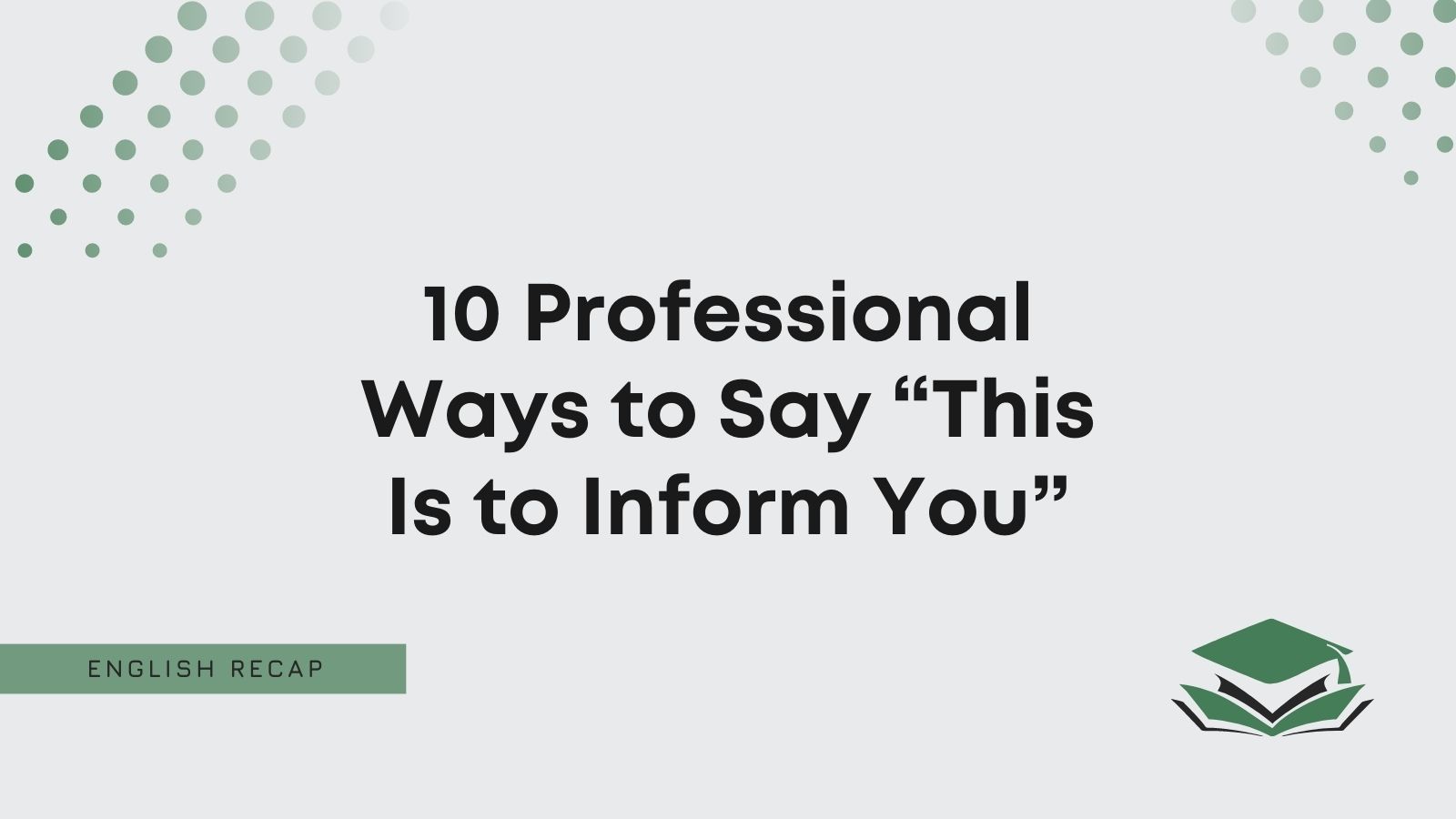So, you’ve just written “this is to inform you,” and now you’re worried it might not work well professionally. Well, you’ve come to the right place.
This article will explain how to write an email to inform in professional situations.
Is It Professional to Say “This Is to Inform You”?
“This is to inform you” is professional and acceptable when sending a formal email. You should use it when you want to get straight to the point politely. It highlights the importance of the email without needing to use too many words.
Pros
- It allows you to highlight the importance of the information in the email.
- It’s very professional and polite.
Cons
- It’s a bit redundant since you can remove it, and most emails still make sense.
- It’s impersonal, so you can never use it informally.
So, even though “this is to inform you” is a professional phrase, it is a bit redundant and impersonal.
Let’s see what we can do with some of the synonyms, then! You never know when they might come in handy to spice up your writing.
Read on to learn about 10 professional alternatives for “this is to inform you.” After all, it’s good practice to have many formal phrases ready for when you need them.
What’s Another Way to Say “This Is to Inform You”?
- I am writing this email to
- This email is to notify you
- The purpose of this email is to inform you
- This is to notify you
- I am emailing to say
- This email serves to inform you
- Just to let you know
- This is just to inform you
- For your information
- For your reference
1. I Am Writing This Email to
Another way of saying “this is to inform you” is with “I am writing this email to.” It’s a great option if you’re sending a bulk email (to students, staff, or a team).
You can use this phrase to remain formal and offer some important information. It’s great to get the attention of everyone involved in the email to let them know that you have some important news.
Here is an email example to show you how it works:
Dear Students,
I am writing this email to let you know that the deadline has changed. Please review the new deadline immediately.
All the best,
Professor Dunkirk
2. This Email Is to Notify You
Another good professional choice is “this email is to notify you.” You should use it when you want to grab someone’s attention quickly. It encourages them to read through the email without missing anything.
So, you should have success with this one when emailing a group of people. Think about using it when starting an email with “Dear Team” or “Dear All” to ensure that everyone understands the contents of your email.
Here’s a sample email to show you how it works:
Dear All,
This email is to notify you that we have filled the two remaining positions. You will have new colleagues on Monday.
Best wishes,
Mr. Barrows
3. The Purpose of This Email Is to Inform You
If you’ve got something important to mention in an email, it’s a good idea to start with a stern message. Saying “the purpose of this email is to inform you” is a great way to show you have something to share.
Generally, a phrase like this at the start of an email indicates bad news rather than good news. It often comes when you’re handing in your resignation or telling an employee that they need to have a disciplinary meeting.
This email example should help you if you’re still unsure:
Dear Students,
The purpose of this email is to inform you that I will be resigning with regret at the end of the semester.
I wish you all the best,
Professor Storm
4. This Is to Notify You
So far, every synonym has mentioned “email” in it. However, you don’t need to. A simpler alternative like “this is to notify you” works well. Also, removing “email” from the phrase allows you to use it either in a business email or a formal letter.
You will have the most luck using this one when emailing a group. After all, it still shows that you want to inform people about information efficiently.
Here’s a quick example email that demonstrates how it works:
Dear Team,
This is to notify you about the change in workplace conduct rules. Please review the attachment.
All the best,
Mr. Rodriguez
5. I Am Emailing to Say
Your professional email tone might vary based on the context of your email. You can say “I am emailing to say” in slightly more casual situations or when you want to give good news to the recipients.
For example, you might email all your employees at the same time with this phrase. You can use it when you want to share your appreciation for the hard work and hours they’ve been putting in lately.
Here is a good example to show you how to use it:
Dear Staff,
I am emailing to say that I appreciate all your hard work lately. You have really stepped up.
Thank you very much,
Ms. Taylor
6. This Email Serves to Inform You
Using terms like “serve” in a formal email works well to convey a respectful attitude. You should use it when you are writing an email as a superior (i.e., if you’re someone’s boss).
You might include it when emailing employees. It’s a good way to give them notice about something that’s relevant to their work.
Here is an email sample to show you how it works:
Dear All,
This email serves to inform you that I will not be in the office for three weeks starting next week.
Best wishes,
Mr. Jacobson
7. Just to Let You Know
You don’t always have to opt for the most professional options. Sometimes, bulk emails benefit from casual phrases like “just to let you know.” It’s still effective when emailing multiple people, but it’s slightly more friendly.
Generally, you can use this phrase in business emails. It shows that you want to share some information with everyone. However, including “just” in the phrase implies that the information isn’t entirely relevant or important.
Here is an email and letter sample to show you how it works:
Dear All,
Just to let you know, I do not plan on going away anymore. I have decided to stay in my current position.
All the best,
Micky Dean
8. This Is Just to Inform You
The more familiar you are with the email recipient, the easier it is to use a casual phrase like “this is just to inform you.” For instance, it can work quite well when emailing students if you are a professor who likes to get stuck in with them.
Whenever you use “just” in an email, it implies that you have something minor to mention. You should never cover important information when using a word like “just,” as it can take away from the impact of whatever you write.
You should review this example if you’re still unsure:
Dear Students,
This is just to inform you that I no longer expect your exams by the end of this week.
Kind regards,
Mr. Peters
9. For Your Information
There are plenty of times when “for your information” comes in handy in formal contexts. You can absolutely use it in business emails to share information that might be relevant to someone.
While some readers might see it as snarky or rude, it’s still a great option. It’s most effective when you are someone’s boss. It shows you are emailing employees and providing information they might have missed.
This email example will also help you:
Dear Harriett,
For your information, they have worked hard on this project. I believe you’ll appreciate the outcome.
Yours,
Dan White
10. For Your Reference
You can also use “for your reference” instead of “this is to inform you” professionally. Though, “for your reference” is a bit more specific.
Generally, “for your reference” works best when attaching a file to an email. It shows you have something specific for the email recipient to refer to, and you would like them to direct their attention toward it.
We recommend using this one when emailing employees and discussing changes at work. It’s best to include an attachment that gives a clear rundown of the changes when using it, though.
This email sample will demonstrate how it works:
Dear Staff,
For your reference, I have attached the new rules. Please review them and reply once you have understood them.
All the best,
Ms. Katter

